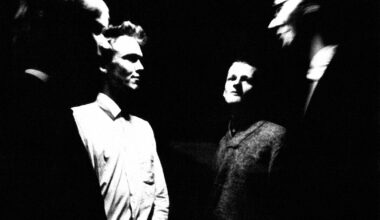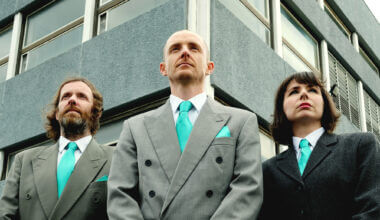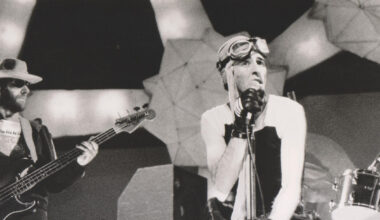How did a box of electronic bits and bobs that cost £50 lead to a boatload of drunk journalists stranded on the Thames and the third biggest selling album of all time? With exclusive access to Tristram Cary’s unpublished memoir, this is the story of the EMS VCS 3, from prototype to production… and beyond
“Board our Thames VCS 3 launch for the musical press launch of a lifetime… and beyond” was the somewhat clunky wording of the invitation that landed in various media outlets’ in-trays one day in 1969. In all likelihood, none of the recipients would have known what a VCS 3 was, or anything about the company that made it, which happened to be called Electronic Music Studios (London) Limited. Telling anyone that the VCS 3 was actually the Voltage Controlled Synthesiser Version 3 would not have helped, either. But that didn’t matter.
The magical words “champagne reception on board” did the trick, and Julian Bray, the young PR consultant whose wheeze this was, welcomed journalists, photographers, TV crews with film cameras, huge lighting rigs and sound recordists on to a Thames launch at Westminster Pier. The idea was that this chaotic crew would be plied with alcohol on the brief journey upstream to meet EMS director, Peter Zinovieff, whose garden at 49 Deodar Road, Putney, in the shadow of the Fulham Railway Bridge, backed on to the Thames. However, a misread tidal timetable meant that they spent an extra half an hour on the boat waiting for the waters to rise sufficiently for them to step over the garden’s back wall. With an open bar on board. “Some of them were disgracefully sauced,” says Julian. “Still, we lost no one, and that was a result.”
For all its jolly British chaos, the launch of the VCS 3 was a monumental event. Here was the first commercially available portable synthesiser in the world, predating the Minimoog by almost a year. It was (relatively) cheap, at £350, half the cost of a Minimoog would be the following year. If that sounds tantalisingly inexpensive, bear in mind that the average salary in the UK in 1970 was £1,600, so it was still a hefty investment, affordable by the likes of Brian Eno, Pink Floyd, the BBC’s Radiophonic Workshop and Hawkwind. The use of the VCS 3, on hits by Roxy Music, the mind-bending ‘The Dark Side Of The Moon’ album, a myriad of BBC radio plays and television shows, and the greasy trucker space rock hit ‘Silver Machine’ all introduced British audiences to the novel products of their homegrown synthesiser company.
The launch of the VCS 3 marked the culmination of a project that sprang from the meeting of three singular characters, Tristram Cary, Peter Zinovieff and David Cockerell. Cary was a well-known composer who had been exploring the possibilities of electronic music for a couple of decades. He’d built his own electronic music studio (quite possibly the first in the UK) at his home in Fressingfield, Suffolk, from bits and bobs picked up at the war surplus electronics shops that once thrived in Lisle Street and Tottenham Court Road in London’s West End. He composed orchestral and electronic music scores, which included early episodes of ‘Doctor Who’ and the Ealing comedy ‘The Ladykillers’ in 1955.
Zinovieff, meanwhile, was a DIY composer with a wealthy wife who helped bankroll his intense explorations into electronic music. He had also been building an electronic music studio for some years, and in 1966 he invited Cary to visit his Deodar Road studio where the pair discussed the current state of electronic music technology. Also present at this meeting was David Cockerell, an unassuming electronics genius who was creating electronic solutions for Zinovieff’s problems with sequencing and electronic sound generation. It didn’t take long for the trio to start discussing creating a British synthesiser to rival the Moog modular system.
The final catalyst was an approach from Don Banks, an Australian composer and friend of Cary’s.
“He happened to turn up at the Putney house,” Cary revealed in his unpublished memoirs, which we’ve been given access to by his son, John. “I knew Don slightly, and he was involved, like me, with films and TV as well as concert music. Don told us that he’d love to get into electronic music, but had absolutely no knowledge of electronics and was quite unable to put the necessary equipment together himself. Also, like me, he was too poor to consider buying a manufactured synthesiser such as the Moog. Could we, he asked, put him together a package of devices which would be useful to a composer – his money limit was £50.”
The trio set about creating the £50 synth, putting together a couple of VCOs, two VCAs, two or three filters, a ring modulator and dubbed it the VCS 1, or Voltage Controlled Synthesiser No 1. It did cost more than £50 to build, but in its creation came the idea of creating a commercially viable machine. Like many great British innovations, much of the scheming was done down the pub, The Cedar Tree on Putney Bridge Road (now the Normanby). They built on the synth they’d created for Banks, added a reverb unit, an extra channel and input amplifiers so that external signals could be brought in and processed. They also designed the machine to allow external control voltages to work the internal devices, and for the output of those internal voltage control signals, making possible a daisy-chain of several synthesisers controlling each other.
A key innovation was the use of the pin matrix to create patches. “The Moog modular relied on patch cords to make connections,” wrote Cary. “If the patch is of any complexity, the front panel becomes a mass of long and short patch cords all over the place, sometimes it’s hard to get at the control knobs behind the ‘knitting’.”
The 16×16 matrix gave the proposed new synthesiser 256 unique connection points, and a much smaller and tidier (and cheaper) solution than Moog’s. “Someone sketched out a shape like a miniature desk with two panels,” wrote Cary, “the upper nearly vertical one to have all the control knobs and the lower, horizontal panel to house the pin matrix, some sort of stowage for pins not in use, and a little joystick by which one could manually generate control voltages.”
Then one weekend back at Fressingfield, Tristram Cary made the wooden box to house the prototype, painted black with panels in white formica. You can’t help wondering if the styling of futuristic devices as seen in The TARDIS or on the USS Enterprise might have some subliminal influence on the design.
“The upper panel I left blank so that David could decide where to drill holes for the knobs,” wrote Cary, “and I mounted the pin matrix and the joystick in the lower part, together with a tray to hold pins. The next day I took the box up to London, and within a couple of days (David was an amazingly fast worker) it was full of circuit boards and hand-labelled knobs, fully wired up and working. We had the very first VCS 3 up and running. A few trims and adjustments were necessary to put everything into a useful working range, but basically it performed as we had hoped. I’m not sure what the VCS 2 was like, or even if there was one, but VCS 3 had a good ring about it and the name stayed.”
The prototype caused considerable interest among visitors to EMS in Putney, and it was occasionally (and very cautiously) loaned out once or twice, but the sooner more examples could be manufactured, the better.

EMS Limited had been formed in 1967, with Cary, Zinovieff and Cockerell as directors, and Cary’s role was to liaise with possible customers among serious composers and the education sector. As EMS moved into production, Cary wrote, he became less involved, busy with his own composing and lecturing at the Royal College of Music.
Getting the word out about the VCS 3 was down to PR man Julian Bray, whose Thames launch stunt had gone down so well. “As a PR account, and one with a small budget, it had huge challenges,” he says. “The number of loan VCS 3s were limited to one, but the initial press and magazine coverage probably boosted Peter’s stock with the bean counters at the BBC, and importantly helped the Radiophonic Workshop, who were his then main customer, to justify its budget.”
Part of the promotion drive relied on a recording of the VCS3 in action, an eight-minute composition by Zinovieff, with the output of the VCS 3 going straight into Bray’s Uher tape recorder.
“I dubbed off and boxed about 50 five-inch spools of quarter-inch tape,” he remembers. “They went with photographs, a biog and a press release to ad agencies, local radio stations, some music producers. I think I personally delivered 15 of them. Peter was against a wider distribution of the tape essentially as he would no longer have direct control over the end use of the tapes. It was his baby after all. But I do know the raw tape I recorded on the Uher did trigger its use by some of the top-line pop groups who acquired their own VCS 3 and later versions of the kit. The groups didn’t treat their kit too well so that was good for repeat business.”
“At various times a succession of young men with interests in the field of rock and pop groups were brought in to interest such groups in the synthesiser,” Cary wrote, somewhat betraying his slight disdain for the low art of pop music, no matter how top-line the groups were. “A few, such as Pink Floyd,” he concedes, “became serious users.”
Although Eno, Floyd and the rest became the best-known standard bearers for the VCS 3, the first album to be recorded solely using one was made in 1971, and released in 1972. The man responsible was Michael Hankinson. British-born but based in South Africa, Hankinson was the in-house composer at a record and film company called RPM. He’d worked at Island Records before leaving for South Africa, and had done some transcription work on the White Noise album, ‘An Electric Storm’.
“I think the reason we used the VCS 3 was that it was affordable,” says Hankinson. “I was frequently in London because I had an interest in a record label there, called Vista. We specialised in organ music, a field without much competition back then.”
An interesting aside here is that the label also released a seven-inch in 1971 called ‘Breakthrough: An Amazing Experiment In Electronic Communication With The Dead’, which was a collection of recordings of Latvian writer Dr Konstantin Raudive’s experiments in “Electronic Voice Phenomena”, tape recordings of, he claimed, voices from the afterlife.
“I visited Peter Zinovieff at his workshop in London and decided it was a great instrument for my project and bought one to be shipped to the Johannesburg studio,” continues Hankinson. “At the same time I made a trip to see the BBC Radiophonic Workshop, the RTF electronic music workshop in Paris, and then to New York to see the RCA Synthesiser where I spent a day with Vladimir Ussachevsky and finally ended up with Gershon Kingsley.”
Hankinson’s album, ‘The Classical Synthesizer’ (it was called ‘The Unusual Classical Synthesizer’ in the USA, which certainly nails it) was a collection of classical music favourites (Bach, Beethoven, Mozart et al), all played on the VCS 3. Hankinson continued using the synth on several more electronic recordings through the 1970s, adding a a battery of ARP machines – a 2600, an Odyssey and a Pro Soloist – for his second album of synthed-up classical works, ‘Synthesia’.
“The main problem with the VCS 3 was the lack of pitch stability of the oscillators and getting the tracking of the keyboard correct to a tempered, Western scale,” says Hankinson. “We used an oscilloscope and signal generator giving an X/Y Lissajou figure to get it right.”
Despite, or perhaps because of, its idiosyncrasies, the VCS 3 was a successful product for EMS, and was followed by smaller and cheaper iterations like the nifty Synthi A (£198), and the monumental and expensive Synthi 100 (£6,500). Their hip and counter-cultural advertising campaigns (‘Every Nun Needs A Synthi’ ran one of their memorable poster and ad campaigns) helped establish their underground cred.
The prototype was homed in Cary’s Fressingfield studio, where it was used alongside two VCS 3 production models. In 1975, he left the company and the UK for a teaching post at Adelaide University and the VCS 3 prototype went with him. As the 1970s progressed EMS began to run out of steam. By the end of the decade they were superseded by Japanese wunderkinds Korg, Roland and Yamaha, and following a badly advised attempt at expansion, the company closed down.
These days, Peter Zinovieff is a little dismissive of the VCS 3, infamously describing EMS as being known for “rather pathetic little synthesisers”, rather than the pioneering research and development they did with computer music. He feels that the synthesiser stifled the urge to experiment.
“It [the synthesiser] promised so much,” he told Electronic Sound in 2013. “It wasn’t able to achieve those promises. But it said you could do anything; think of a sound, now make it. How could people not be interested? Then there was a bit of a fizzle out, because synths said ‘alright, here it is, it’s all self-contained, this is what you can do’ so there wasn’t really any reason to have experimental studios, because people thought, ‘I’ve got it all’.”
Where Are They Now?
Vcs 3 Prototype
Today, a VCS 3 will cost you the best part of £10,000, if not more. If you can find one. The Tristram Cary-built prototype is a museum piece, and did indeed become an exhibit at the tiny Diss Museum (near to Fressingfield) in 2016, in a small display of Tristram Cary’s effects. But a synthesiser doesn’t belong behind glass. It needs to create electronic sound, which is why the unique machine is currently with us here at Electronic Sound being lovingly restored by our very own Synthesiser Dave. So far, he tells us, he can see that the reverb unit has been cannibalised, and that there are some electronics which spiral off the bread board with no apparent purpose. If and when we get it singing again, you will be the first to know.
Tristram Cary
After leaving the UK in 1975, Tristram Cary took up a teaching post at the University of Adelaide, Australia, until 1985. He was awarded the Medal Of The Order of Australia in 1991 in recognition of service to music and in 2005 he received the lifetime achievement award from the Adelaide Critics’ Circle for his contribution to music in England and Australia. He died in Australia in 2008, aged 82.
Peter Zinovieff
Following the demise of EMS (London) Limited in 1979, Zinovieff left London and made his home on the island of Raasay where he continued experimenting with computers, using electricity generated by a windmill. He worked with Clive Sinclair developing music programmes for his groundbreaking ZX home computers. He then moved back to Cambridge to take up a post teaching acoustics at Cambridge University and set up another private electronic music studio. He returned to public composing again in 2010 and a compilation of his earlier work, ‘The Electronic Calendar: The EMS Tapes’ was released by Pete Kember’s (Sonic Boom) Space Age Recordings label in 2015.
David Cockerell
David Cockerell saw “the writing on the wall” for EMS when Korg’s first synths were released and he starting working for Electro Harmonix creating effects pedals, including the Electric Mistress in 1976, the first flanger that could be used on stage. He then had a stint at IRCAM (Institut de Recherche et Coordination Acoustique/Musique) in Paris, before joining Akai where he helped develop the Akai S900 sampler. He rejoined Electro-Harmonix and was still there in 2012, making units like the POG (Polyphonic Octave Generator).
Michael Hankinson
After his stint as in-house composer at the South African film and TV company RPM, he moved to Durban where he formed a contemporary music group called Soundwaves and became the director of the Durban Philharmonic Orchestra. He went on to conduct and compose for the State Theatre in Pretoria, Johannesburg Philharmonic and the Cape Town City Ballet. He scored the first Zulu opera in 2002. Now living in Norfolk, he is still composing for music libraries as well more serious pieces and he conducts occasionally, too.
Julian Bray
Julian worked as a broadcaster for the BBC and then for commercial TV and radio stations in the UK and Europe, with a specialism in aviation safety. He became the CEO at Leadenhall Associates and advisor to former Italian prime minister Romano Prodi and advised several governments on air disaster rescue and recovery strategies. He’s also a member of the Magic Circle, performing as Ian Ray.
Don Banks
Don Banks was an Australian composer. He moved to London in 1950 and alongside his own serious compositions, started composing music for films and TV, including cartoons and Hammer horror movies like ‘The Evil Of Frankenstein’ and ‘The Reptile’. He began using electronic music in the mid-60s, becoming a founding member of the British Society For Electronic Music. He returned to Australia in 1972 where he became Head of Composition And Electronic Music Studies at the Canberra School Of Music and in 1978 he was appointed Head of the School of Composition Studies at the New South Wales Conservatorium of Music. He died in 1980 of leukaemia.






